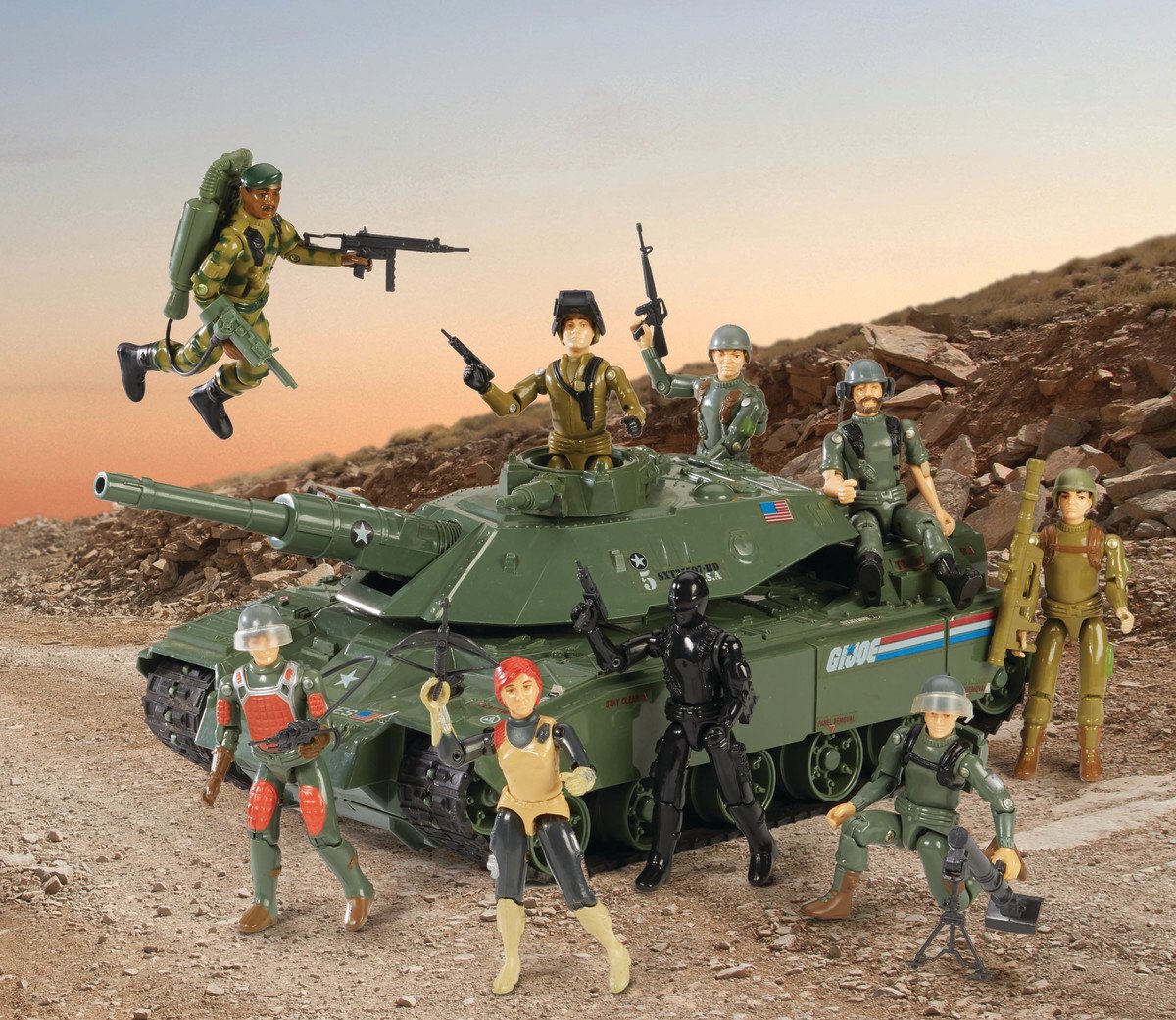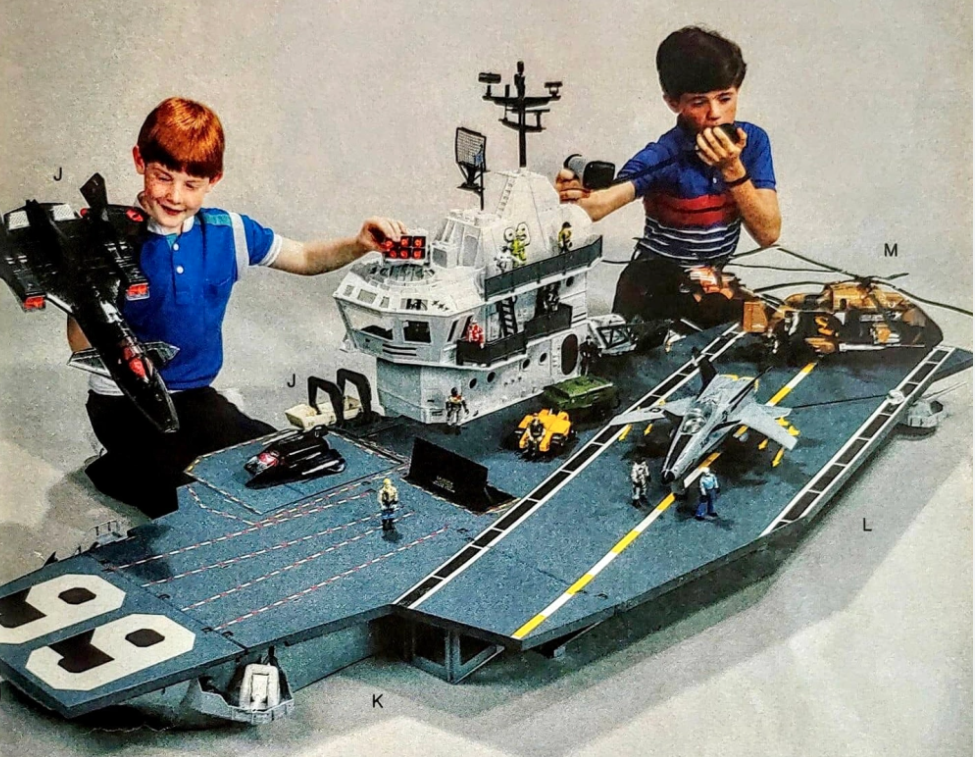A Look Back at the Iconic 1980s G.I. Joe Toyline
The 1980s were the golden age of action figure toy lines. If you grew up in that decade, memories of toy line commercials, full toy store racks, and toy line-inspired cartoons are abundant with flashes of iconic franchises like He-Man, Transformers, M.A.S.K., and Thundercats. Each toy line had its unique appeal and memorable designs, accompanied by loyal followings.
However, the 1980s-era 3 ¾-inch G.I. Joe line represents the best of the best, with hugely successful sales above its peers, a massively successful pop culture phenom cartoon series, and a comic book series still going strong today.
Which Toy Company Brought G.I. Joe to Life?
In 1923, three Providence, Rhode Island entrepreneurial-spirited brothers — Herman, Hillel, and Henry Hassenfeld (aka the Hasbros) — created a company called Hassenfeld Brothers, initially carving its niche in the textile remnants industry. The company later branched out into manufacturing pencil cases and various school supplies. In the late 1940s, the company shifted towards toy production, eventually taking on the name Hasbro Industries in 1968. It quickly became a powerhouse in the world of toys and entertainment — a powerhouse we now know as Hasbro.
G.I. Is Born
Hasbro’s original G.I. Joe line debuted in 1964 as a 12-inch figure accessorized with different military outfits. The line was a direct response to Mattel’s hugely successful Barbie doll line for girls. Hasbro wanted to create an equivalent phenomenon for the male demographic. G.I. Joe was born. The design embodied the American soldier, creating the perfect doll — er, action figure — that boys could play with, accessorize, and collect.
The 12-inch G.I. Joe eventually faded away in the late 1970s. After the success of the Star Wars toy line in the late 1970s and early 1980s, Hasbro decided to once again follow the success of another toy line — this time taking their G.I. Joe toy brand to new heights, in a shorter form compared to their previous 12-inch figures.
The company reinvented the brand by shifting to a scaled-down size similar to Star Wars action figures — 3 ¾-inch. This move was also a cost-effective way to cut down on the action figure-line budget, saving the company nearly 70% of the cost of plastic per figure compared to the previous 12-inch scale figures.
One advantage the G.I. Joe figures had over the Star Wars 3 ¾-inch figures was the addition of more points of articulation. G.I. Joe figures typically had 14 points of articulation, including the neck, shoulders, elbows, wrists, waist, hips, and knees.
This level of articulation allowed for a wide range of motion and more dynamic poses, setting a new standard for action figures. The Star Wars figures only had 5 points of articulation in the neck, shoulders, and hips.
The scaled-down 3 ¾-inch action figure would also make it possible to do what the Star Wars line did so successfully — allowing the ability to launch a line of vehicles for the action figures to inhabit. But instead of X-Wings and T.I.E. Fighters of the Star Wars line, the revamped and resized G.I. Joe line offered children realistic military vehicles like jeeps, tanks, jets, and helicopters.
This was something that would have been far too expensive — and too big as well — for the 12-inch figures to fit in.
Hasbro also made another significant change to the brand. Instead of different variations of the same character (G.I. Joe), the new line would introduce multiple characters accompanied by a broader storyline.
G.I. Joe was now a code name for a team of specialized operatives fighting against Cobra, a ruthless terrorist organization determined to rule the world — a good versus evil narrative that allowed children the opportunity to create their own stories while playing in their backyards with the toys. Having a diverse cast of characters also meant more opportunities to drive sales.
Expanding the G.I. Joe Universe
The backbone of the G.I. Joe toy line was its expanded universe. What better way to get children to buy your toys than to create a cartoon they can watch and comics they can read? Under the guidance of comic writer Larry Hama, additional depth and complexity were added to the G.I. Joe storyline.
The Marvel comic allowed Hama to go deeper into the backstories of the Joes.
The Sunbow cartoon took G.I. Joe to even greater franchise awareness, soon becoming a cultural phenomenon in its own right. It began with two animated miniseries that debuted on Saturday mornings — later becoming a weekly series in 1985.
Standout G.I. Joe Action Figures, Vehicles, and Playsets
Over the years, the 3 ¾-inch G.I. Joes came out with dozens upon dozens of action figures each year, accompanied by an ever-growing fleet of air, land, and water vehicles — even some space ones.
Snake Eyes and Storm Shadow
When it comes to the action figures, two specific characters — forty-plus years later — are synonymous with the brand. Snake Eyes, with his mysterious background and black ninja attire, and Storm Shadow, his Cobra counterpart dressed in white ninja, remain the two most coveted collectible action figures from the line.
There are plenty of other marque G.I. Joe and Cobra figures but Snake Eyes and Storm Shadow stand apart.
When it comes to vehicles and playsets, G.I. Joe had many gems each year in the 1980s.
G.I. Joe Headquarters Command Center
The G.I. Joe Headquarters Command Center — featured prominently in the cartoon and comics — was first released in toy stores in 1983. The toy set consisted of four sections:
The command console and stockade section featured swivel seats, a movable instrument cover, and two storage levels of weapons armory.
A heavy equipment supply depot section had a file card storage compartment and a gun rack to hang weapons on.
A motor pool section came equipped with a movable mechanic's lift for G.I. Joe vehicles and weapons, and another gun rack to hang weapons on.
There was even a helipad for various G.I. Joe helicopters and aircraft.
It is one of the most iconic playsets of the G.I. Joe brand.
G.I. Joe Defiant Space Vehicle Launch Complex
An even larger playset came in the form of 1987’s G.I. Joe Defiant Space Vehicle Launch Complex. This expansive set featured a detailed space shuttle — capable of housing two astronauts — attached to a massive booster unit. The complex also included a structure for shuttle preparation and launch, as well as a command center equipped with sophisticated controls and defenses.
Click Here to Buy the G.I. Joe Defiant Now at The Toys of Our Lives!
U.S.S. Flagg Aircraft Carrier
No vehicle or playset of any toy line matched the scope of the U.S.S. Flagg Aircraft Carrier, an enormous and detailed vehicle/playset that measured seven feet long! It is perhaps the most legendary of any G.I. Joe or Cobra vehicle and playset. Its sheer size and intricate design have made it the “holy grail” among die-hard G.I. Joe collectors.
Collectibility of G.I. Joe Toys
The legacy of the G.I. Joe toy line is evident not only in the continued popularity of the brand but also in the dedicated collector community that thrives to this day. There is a robust secondary market for vintage figures and vehicles — a testament to the enduring appeal of G.I. Joe. The brand has seen various revivals and reinterpretations over the years, but for most, the 1980s golden era of the 3 3/4-inch figures and their accompanying vehicles and playsets remains unmatched. It is one of the most highly collectible toy lines in history.









